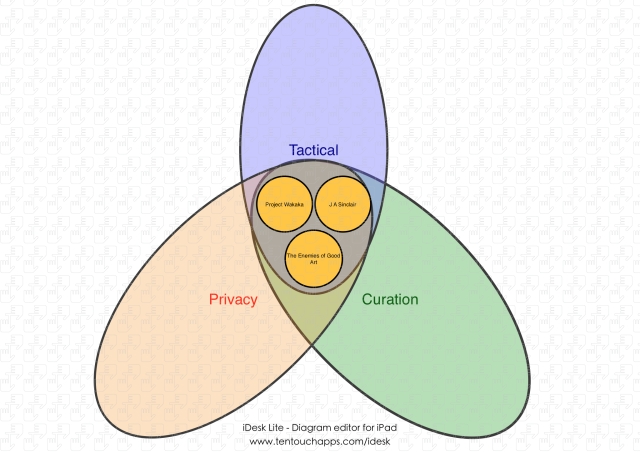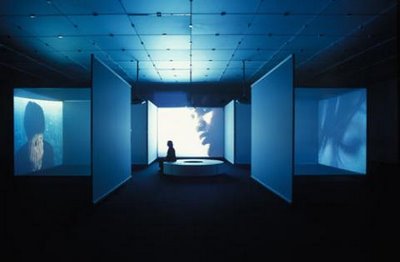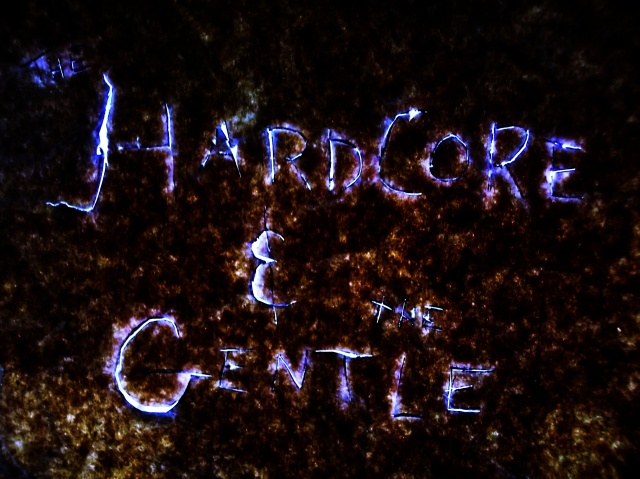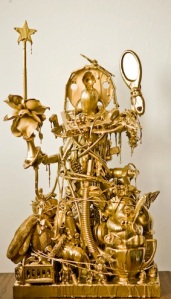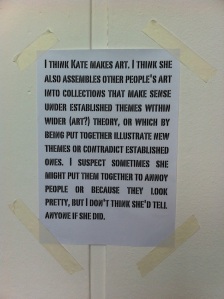Past Posts
My Twitterings
Tweets by gilbertbearMy Other Pages
 Art Rabbit
Art Rabbit- An error has occurred; the feed is probably down. Try again later.
 Self Selector
Self Selector- On Hope and Dread in Nuclear Times: Ana Vaz’s Long Voyage Out
- On the liberation upon hearing in the intermediate state
- Perverse Love and Woman as Cipher in Phantom Thread
- ‘Ruin Lust’ at Tate Britain
- Braco Dimitrijević’s ‘Early London Years’
- Reading as community: Dora García and The Joycean Society
- Richard Sides at Carlos/Ishikawa
- Writing Process Blog Tour
- Review of Frieze Art Fair 2013
- Jodorowsky’s Santa Sangre: Every unhappy family is unhappy in its own way
 Aesthetica Magazine
Aesthetica Magazine- Image and Identity in Iran | Bi Nam | Ffotogallery | Penarth
- Daniel Linehan: Zombie Aporia | Lilian Baylis Studio | Sadler's Wells Theatre | London
- Sara Greavu & Phil Hession: Titanic Toast | Golden Thread Gallery | Belfast
- ASFF 2012: ONE MONTH TO GO! SUBMIT TODAY TO SCREEN YOUR FILM
- The Viewer as Spectator, Subject or Performer | The Catlin Art Prize 2012 | Interview with Poppy Bisdee
- Dialogues With The Physical | The Space Between | Tate Britain
- Art Doesn't Act and Doesn't Work | Forget Fear | The 7th Berlin Biennale For Contemporary Art
- Big Brother is Watching You: David Dunnico: 1984 Looks Like This | Salford Museum & Art Gallery
- Currents 106: Chelsea Knight | Saint Louis Art Museum | Missouri
- Miró: Sculptor | Yorkshire Sculpture Park | Wakefield
 Contemporary Art Scotland
Contemporary Art Scotland- DOES THE IT STICK
- Rhubaba presents Well-Done: Tom Varley
- Join the Rhubaba Choir! This Thursday, 6pm.
- PNCA announces The Hannah Arendt Prize, call for submissions
- OCCUPY THE FUTURE / THE PROSPECT OF A UTOPIAN SCOTLAND / ANTHONY SCHRAG
- ECONOMY Website Launch: A curatorial project led by the History of Art department at the University of Edinburgh
- Upcoming at Embassy Gallery | PERFORMANCE | Christmas Toddlers and Tiaras Beauty Pageant | 7-9PM | 10b Broughton St. Lane
- The Long Game, Friday 7th December, The Old Hairdressers, Renfield Lane.
- Walking off the Grid Discussion
- Three-fold - In Conversation w/ Catherine Street, Alexandra Ross and Catherine Payton
 Cathedral of Shit
Cathedral of Shit Arts Journal
Arts Journal- An error has occurred; the feed is probably down. Try again later.
 Creative Review
Creative Review- An error has occurred; the feed is probably down. Try again later.
 Kneel, Mulholland: Drive!
Kneel, Mulholland: Drive!- New Site
- 'Visitor Centre' | A Grand Tour
- Shift/Work
- Jo Robertson | Mayonnaise
- No-One Driving (Redux) at Performing Art History
- Steven Campbell Masterclass with Bruce McLean
- Terry Atkinson Expanded Painting Workshop
- The Steven Campbell Trust Master Class 2011
- Radical Scotland: Arguments for Self-Determination
- 'Avalon', Embassy e-book
 AHM
AHM- Changin Scotland - Scotland’s alternative festival of ideas, culture and politics - 1st - 3rd November 2013 - Newbattle Abbey College
- Conference report: Arts and identity at 'Changin' Scotland'
- 'Changin' Scotland - photos from the event
- Changing Scotland conference programme
- Here Comes Langholm: Birthplace of Hugh MacDiarmid: An Introduction by Alan Riach
- Hugh MacDiarmid Exhibition
- Beyond the Frame article
- Beyond the Frame - Contemporary Cuban Art
- AHM organise 'The Arts in a New Scotland' at the Ceilidh Place, Ullapool
- Untitled
 Art Fag City
Art Fag City- The NFT Explain Me with Marina Galperina and Amy Whitaker
- Goodbye 2020, Goodbye R.M. Vaughan
- Explain me With Art Critic Ben Davis: The Year That Wasn’t, Part Two
- Explain Me With Art Critic Ben Davis: The Year That Wasn’t, Part One
- Explain Me with Andy Adams of FlakPhoto: From Idyllic Photos to The Surveillance State
- Zombie Figuration Isn’t a Thing: A Critical Autopsy with Antwaun Sargent
- Institutional failure, Trump’s Agenda, and Meme-Driven Conservative Movements: A Talk with Nayland Blake
- Revolution for the Family: Heather Bhandari and Nikki Columbus on Pandemic Parenting, Art, and Activism
- From L.A. With Love: Thoughts on Online Viewing Rooms, Museum Layoffs, and More with Carolina Miranda and Michael Shaw
- Explain Me with Jonathan Schwartz of Atelier4 and Magda Sawon of Postmasters
 Jonathan Jones
Jonathan Jones- Meet Jacob Burckhardt, the thinker who invented 'culture' | Jonathan Jones
- Tate Britain could be our greatest museum – if it only loved its treasures
- Jeff Koons' Louis Vuitton bags: a joyous art history lesson
- Feminism doesn't need more female statues – it needs political action
- Trafalgar Square's fourth plinth is fine for horses, but not avant garde art
- The beauty of art can counter Islamophobia – but it won't be easy
- Pop art's American dream is over – and a zombie culture has begun
- Put away the gallery guides – art is best when shrouded in mystery
- The American art scene is dying of philistinism | Jonathan Jones
- De Stijl turns 100 – but still cannot touch the greats of abstract act
 Fin Kennedy
Fin Kennedy- An error has occurred; the feed is probably down. Try again later.
 VerySmallKitchen
VerySmallKitchen- VSK PROJECT: AND TO CRY OUT by MIRA MATTAR
- NEW PUBLICATION: MENTAL FURNITURE by CLAIRE POTTER
- VSK PROJECT: SPHERICAL MOUTH FEEL by REBECCA JAGOE
- VSK PROJECT: HYPERMODERNISM (SHELF 2) by DAVID PRICE
- VSK PROJECT: THINGS DONE by KASPER ANDREASEN
- VSK PROJECT: TO RESPOND TO DAVID WITH SOMETHING ERM FOR THE BLOG by PATRICK COYLE
- VSK PROJECT: I HAVE ONLY ONE OBJECTIVE: TO CREATE A BOOK by EMMA BOLLAND
- VSK PROJECT: HYPERMODERNISM DRAWER ONE (AN EXTRACTION) by DAVID PRICE
- NEW PUBLICATION: 2 BLUE CUPS ON TWO DIFFERENT CORNERS OF THE TABLE by OHAD BEN SHIMON
- VSK PROJECT: RESISTANCE AS PARADOX and TWO OTHER TEXTS by JACOB WREN
 Bokship
Bokship- An error has occurred; the feed is probably down. Try again later.
 Owen Jones
Owen Jones- An error has occurred; the feed is probably down. Try again later.
 xanderhough
xanderhough Matthew Linley
Matthew Linley- Artist International Development Award
- The buzz on Horny Handed Tons of Soil
- Nina Reviews and Articles
- Nina – a story about me and Nina Simone …..the Uk tour dates
- The Leaving of Liverpool
- This Christmas – see a Unity show in Liverpool, Stockholm, Manchester and Kendal
- Grrr….overly complicated train ticketing
- Nina – a story about me and Nina Simone to tour in 2018
- From Somalia to Liverpool a brilliant week of new work at Unity
- Z Arts and STUN artist lab… for BAME or Disabled Artist interested in Making Theatre for Children and Young People?
 Bright Grenn
Bright Grenn- An error has occurred; the feed is probably down. Try again later.
Uninvited Outsider Opens for Business
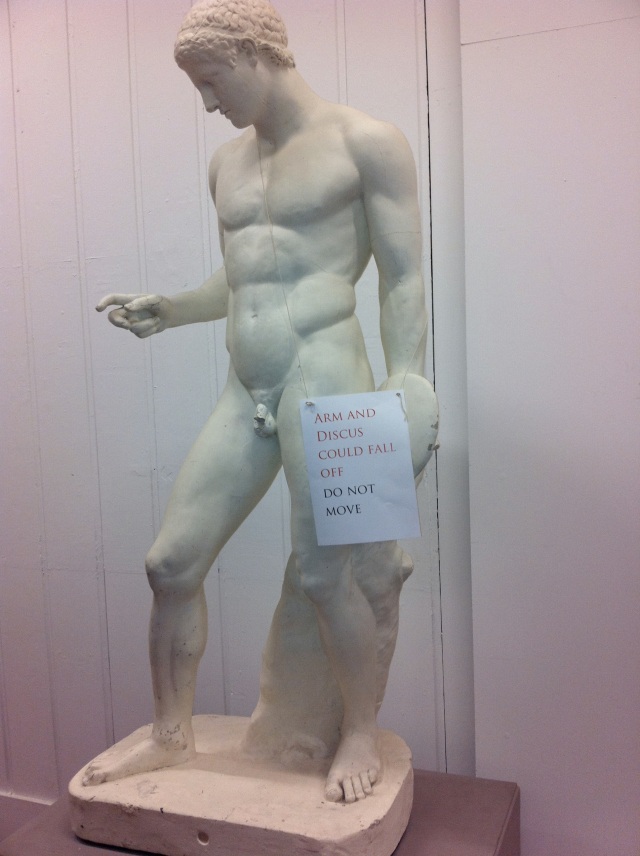 Arms and Discus could fall…. disaster could ensue….
Arms and Discus could fall…. disaster could ensue….
I have now set up a new blog. Uninvited Outsider is dedicated entirely to my personal curatorial projects. The blog acts as a site to promote the projects but also a place to critique all the activities involved through writing and discussion. Anyone can post a response or ask a question. Please come and visit.
http://uninvitedoutsider.tumblr.com/
Consequently posts here may slow down for the time being. Normal service will resume shortly meanwhile here is a picture of a man with a broken penis an a crumbly arm….
Posted in Uncategorized
Leave a comment
The Network Will Eat Itself.
Networking at Networked the Triangle Network Networking Conference.
It is quite easy to see how important the making and using of networks is to any artist. Art isn’t art without the communication and confirmation provided by a community of peers. Art is communication, made in isolation it fails to fulfill its objects.
The Triangle Network began, as carefully pointed out by Anthony Caro in his opening statement at the conference, before the notion of artists networks become explicit and publicly iterated. But the Triangle Network (or Triangle as it began) was the vanguard of that trend and as such could be considered responsible for the plethora of other networks whose representatives populated the conference floor.
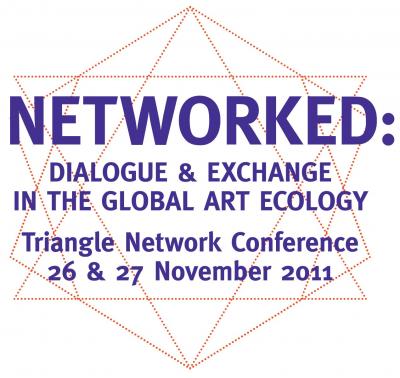
A network is a social state, and in its proper and purest form must be without hierarchy, top down instigation or management and have a flexible if not totally lose financial structure. All these points and definitions were raised at the conference many times. What happens to a network when it becomes a charity, membership organisation, collective, business, or gains some other institutional structure? When a network becomes anything more than a lose association at what point does its function as a network disintegrate and its purpose become lost?
Unfortunately for the conference organisers there was much talking around these ideas but, as ever with large conference events, few conclusions or truly interrogatory discussions emerged. The best that could be brought away from the event – and this only from continuous mentions of the fact from the floor – was the following;
- Networks arise from a perceived need by a group of individuals.
- Networks lose their vitality when that organisation is taken away from members and ends up being controlled by an organising committee.
- The organisation and running of these networks tends to fall on one or two individuals within the network.
- Networks that remain in their original form continue inevitably to be poor.
- Where they don’t provide funds what they do provide is mutual support and peer contact.
- When the perceived need disappears the network may well disintegrate, but this is OK as the need has also gone.
- Artificial preservation of networks is therefore quite futile.
All this is very well but ignores one of the oddest attributes of the conference. Located within the Bloomberg conference space in central London it was taking place at the time when the occupy protests were in situ in the square directly outside the building. Where Bloomberg is as far away from a participatory Network as an organisation can be the Occupy movement seemed to embody, for the course of the weekend, a perfect example of a Network created on a non hierarchical footing at the point of a perceived need. It is understandable therefore that many conference delegates talked with great discomfort about their situation as creating a voice for the individuals that formed the networks they represented, and appeared to feel deeply out of place in their environment.
In the end few networks stood out as being of particular interest, those mostly being…. The Hub, ArtsAdmin (is it really a network?) Arts Rights Justice (again not really a network but uses them to great effect) Independent Curators International and WeFund.
But for the rest of the party the conference acted as an odd uber-networking event; organisations and representatives of small, localised networks from around the world networked with each other about the networks they were part of, further expanding their reach into the network. In amongst all this inter-communication what might be too easily lost is the purpose for which the networks began in the first place. To know there are other tiny groups of artists scattered around the world all battling the same demons is reassuring; yet the conversations in the Bloomberg space seemed too far abstracted from their day to day reality to achieve anything significant. More interesting is the blog, which continues before after and beyond the conference walls, now linked to from this page.
Posted in Uncategorized
Leave a comment
Beginnings of “The Privacy Tactic”…
Looking closely into the nature of privacy within art and curatorial practice has made me consider the domestic as an alternative site for art practice and curation. Two such projects were presented recently at Collective’s Artists’ DIY Soapbox. J A Sinclair and Project Wakaka were both created out of necessity and are based in the flats and houses of their initiators and curators. Thought both projects have different emphases and aims they are linked by their domestic situation. Project Wakaka was developed by artist and mother Jennie Temple in her house as a way of developing projects along side the responsibilities of motherhood. In this sense it is very like a much larger, more established project Enemies of Good Art. Both could be read within a feminist framework, though looking at these projects solely through this lens would do them both a real disservice as neither has been created from an overt feminist standpoint. This is where these two projects benefit by comparison to J. A. Sinclair, which also has a domestic setting but for reasons of economy and control, as well as an element of non-conformism, not out of a domestic or familial need. The talk at Collective by project curators Susan Gladwin and Andrew Gannon brought out many interesting issues namely their aims as curators when their gallery is such an overtly private and selective affair. Although this might create possible problems for the project as something of value; criticism leveled at the project included that it was simply a way for the pair to be the collectors of art projects (as opposed to objects) and that their work might not be properly framed as curatorial at all. I object to this criticism as an audience is created for the works in the activities of J A Sinclair, though the curators take on the role of a special kind of audience with a deeper involvement in the work than many, this does not stop their practice from being a project of curation.
Of course what is needed here is a definition of curation; still an ever-fluctuating field of activity and a question too large to go into in detail here. Yet what links these domestic galleries, perhaps better termed “sites for curation” for the sake of this argument, is that they take on the characteristics of tactical activities, as framed by Michel De Certeau in The Practice of Everyday Life. The conjunction of privacy, curation and tactical activity in these projects make domesticity a pivotal starting point for looking at privacy as a possible tactic within wider curatorial practice.
Interestingly, tactical curation is something that Boris Groys in his e-flux essay Politics of Installation implies to be impossible. However, the state of affairs that he has assumed to be the case in a very simplistic picture of what curatorial activity can involve. My future research project, which now has it’s own page on this blog, will look closely at the private as a locus for an experiment in tactical curation with the aim of creating a framework in which Groys’ assumption can be thoroughly probed, questioned and hopefully reconsidered.
This posts marks the beginning of the investigative project “The Privacy Tactic – link at the top of this page…follow 09. The Privacy Tactic for further elaboration on these ideas…
Posted in Uncategorized
Leave a comment
A deviation…before The Hardcore & The Gentle
The creation of the CO2 space exhibition The Hardcore and The Gentle has provided many interesting avenues for thought and discussion during its creation. Some of which will be, at best, only tangentially evident in the final work. One worth noting here is a brief discussion on abstract animation and experiential cinema. Tracing a very VERY simple line of development it is possible to see the ongoing influence of early abstract animators Len Lye (a cult figure and early pioneer) and Mary E. Bute (the animator whose work was “lovingly riped off” by Walt Disney and chums for The bit of Fantasia that doesn’t have micky mouse, broomsticks or dancing hippos).
The combination of music and animated abstraction perhaps more easily meshes when digital synthesised animation and music can be created together.
When considering works like this being shown in a gallery space the link from animated abstraction (evident in the work of Oskar Fischinger as well as Lye and Bute) through immersive experiences (as created by the Boyle Family and Gustav Metzger in the 1960s) to the embodied experience of the 1990s/2000s video installation can be easily identified.
How the altering light from a screen impacts a room, and heightens the experience within it, is now so common place to anyone watching a scary movie on their home cinema as to be perhaps beyond the realm of art experience.
 Nevertheless there is a history of experiences to acknowledge in creating a space that, whilst not using film directly, is as indebted to cinematic experience as it is to architectural and religious ones.
Nevertheless there is a history of experiences to acknowledge in creating a space that, whilst not using film directly, is as indebted to cinematic experience as it is to architectural and religious ones.
The Hardcore and The Gentle will OPEN in the Co2 Project Space at ECA On Friday 28th October 2011 16:30 – 18:30
Posted in Uncategorized
Leave a comment
Public and Private – Post 1.
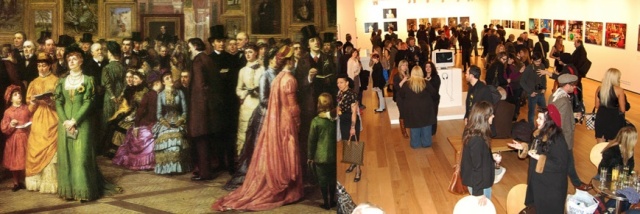 The nature of the gallery space as either public or private was a topic brought up for debate yet again this week. This time in the context of the Variant organised workshop on Creative Scotland funding changes which happened this past Saturday. Our small group break out sessions veered off for a while into a discussion of how public a small artist-led gallery space actually is? Who is it’s public? And what constitutes a public space in general? These issues keep raising their head – particularly whenever the subject of public funding is at issue. There is also a metaphysical element to any discussion of the public nature of a space [Exemplified in Boris Groys’ essay Politics of Installation] and an ongoing debate that impinges into essays where Public Space is not the primary subject – read from page 7 of this months Art Monthly. Such is the wide ranging nature of this issue that it is a subject I continue to return to and will be focusing on more and more through the development of my final MFA project. Expect further posts on the subject and perhaps a dedicated website…more news soon.
The nature of the gallery space as either public or private was a topic brought up for debate yet again this week. This time in the context of the Variant organised workshop on Creative Scotland funding changes which happened this past Saturday. Our small group break out sessions veered off for a while into a discussion of how public a small artist-led gallery space actually is? Who is it’s public? And what constitutes a public space in general? These issues keep raising their head – particularly whenever the subject of public funding is at issue. There is also a metaphysical element to any discussion of the public nature of a space [Exemplified in Boris Groys’ essay Politics of Installation] and an ongoing debate that impinges into essays where Public Space is not the primary subject – read from page 7 of this months Art Monthly. Such is the wide ranging nature of this issue that it is a subject I continue to return to and will be focusing on more and more through the development of my final MFA project. Expect further posts on the subject and perhaps a dedicated website…more news soon.
Posted in Uncategorized
Leave a comment
The Best Gallery Bench in The World
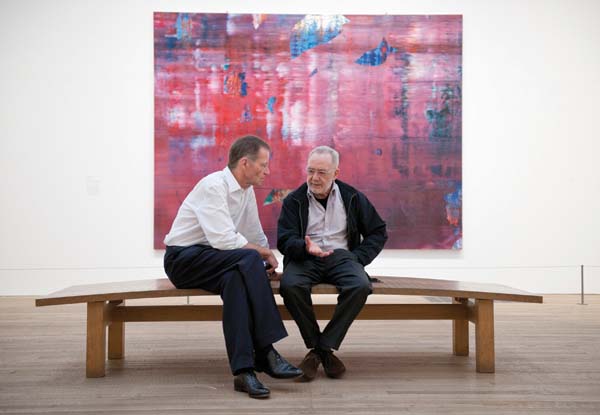 Nick and Gerhard model the latest in bespoke designer seating solutions – for all your elite international world-class contemporary gallery needs. Our benches have been designed to the highest spec by our in house design team – Herzog and de Meuron – and allow for full appreciation of the seated experience whilst maintaining a stripped back Scandinavian aesthetic so it wont clash with your minimal white cube interior. (painting sold separately).
Nick and Gerhard model the latest in bespoke designer seating solutions – for all your elite international world-class contemporary gallery needs. Our benches have been designed to the highest spec by our in house design team – Herzog and de Meuron – and allow for full appreciation of the seated experience whilst maintaining a stripped back Scandinavian aesthetic so it wont clash with your minimal white cube interior. (painting sold separately).
Posted in Uncategorized
Leave a comment
CO2 – Project Collaboration between myself, and artists Simone Pereira Hind and Brittonie Fletcher.
With less than 4 weeks to between first meeting and final realized project the turn around for this project is necessarily quick, however a sense of commonly held values and interests was discovered even on day one. These include the use, manipulation and effects of light on personal, and perhaps communal experience. The problem of how a personal experience might be communicated through art; and, indeed, whether this was necessary or even possible.
Contrasts between the artists are inevitable and while Brittonie’s work seems sensitive, melancholic, and mysterious [Brittonie’s Blog] Simone celebrates the gaudy, brash and trashy [Simone’s Blog].
Communal ground can be found in the fact that both artists like to work directly with materiality of light responsive surfaces and because of this a special dimension is necessary to both the artists work. Through discussion the nature of space created to enhance or evoke religious experience was discussed. A fascination with the power and effect, often physical, of these spaces on the mind and body has had a considerable impact on the research project so far.
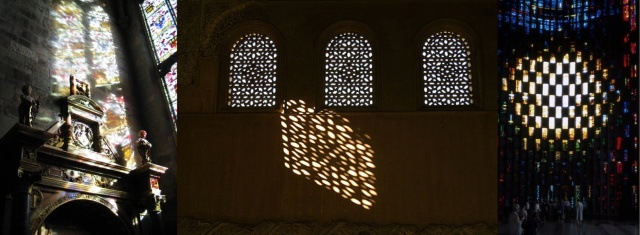 Coupled with this all three collaborators bear a common dislike of the CO2Space and the standard format for discourse that the space repeatedly implicates week on week. Consequently a direct intervention into the CO2 space has become an inevitable focus for the trio in moving the project onward.
Coupled with this all three collaborators bear a common dislike of the CO2Space and the standard format for discourse that the space repeatedly implicates week on week. Consequently a direct intervention into the CO2 space has become an inevitable focus for the trio in moving the project onward.

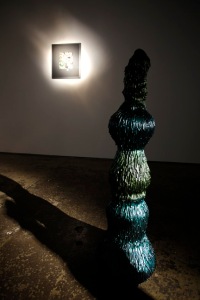 The discussion for me brought to mind the work of Ragnar Jonasson – recently shown at +44 141 Gallery at SWG3, Glasgow. This show used direct lighting to disrupt the conventional experience of a white cube gallery space, making the space subservient to the work and not vice versa.
The discussion for me brought to mind the work of Ragnar Jonasson – recently shown at +44 141 Gallery at SWG3, Glasgow. This show used direct lighting to disrupt the conventional experience of a white cube gallery space, making the space subservient to the work and not vice versa.
In terms of research, for me the project’s major interest lies in the disruption of conventional behaviours of the ‘public’ when the space is finally opened up to them at the end of the project. The question of art as experience raises its head again; as well as the understandings of public and private space involved. Most pertinently, and something I intend to return to in future discussions before the project ends; how this form of practice manifests as a research project and what outcomes can be said to be gained…
Posted in Uncategorized
Leave a comment
Manifesto
A Personal Manifesto…of sorts (written by my brother – make of it what you will) signaling a new season of postings and updates to the site as well as further projects and exhibitions coming soon (I hope!)
Posted in Uncategorized
Leave a comment
On Things and Stuff.
Coming across two recent books on material culture I have begun to contemplate the possibility and potential importance of defining a comparative study of “Things” and “Stuff”.


Daniel Miller’s 2010 analysis of Stuff (ISBN 978-0-7456-4424-0) follows relatively fast on the heels of Bill Browns 2004 discussion of Things (ISBN 978-0-2260-7612-6). Due to over-demand at the University of Edinburgh Library I have yet to get my hands on both these books at the same time yet individual analysis of the texts has led me to ponder the subtle differences between the two terms. It is worth noting that Daniel Miller has also written extensively about “Things” as well as “Stuff”. His book, The Comfort of Things, is a personal account of a anthropological research project; the first two chapters of which should be essential reading for anyone, like me, who is a perpetual hoarder of all things financially worthless yet sentimentally irreplaceable. The book provides great peace-of-mind to those of us made anxious about our personal effects by peer pressure from both the left-wing arty crowd (who would have one eschew the ownership of too many things as an act of defiance against bourgeois decadence) acting in a pincer movement with the self-same bourgeois, aspirational lifestyle gurus from the Sunday papers and interior magazines (who allow the accumulation of things as long as they are self-consciously expensive and selected and arranged in suitable positions around the home as part of a personal lifestyle statement). Is a house full of “Things” perhaps then, just the physical manifestation of wishy-washy, flip-flopping liberality?
If so, where does that leave “Stuff”. I think I own quite a lot of that too. But “Stuff” has the more negative connotation of the overflow of the worthless. As I sit here the desk in front of me is brimming with unnecessary stuff; the accumulated detritus of weeks of working mostly from home. Currently within easy reach amongst the desktop clutter are: a small pile of DVDs, a bottle of multi-surface spray and near finished roll of kitchen paper from where I hastily wiped up a spilled cut of tea, a pot of moisturising lotion, a half empty pot of Vitamin C, a lip balm, a glue stick and stapler, a role of electrical tape, a pot of map pins, a half eaten bag of crisps, two empty tea mugs and an empty glass, the debit card I was logging into my online bank account with earlier today, leaflets from two art galleries and an artists organisation, a large pair of scissors and a 3B pencil. None of the items in this collection of stuff could ever be considered a “Thing” that has significance to me or that could not be easily replaced by a trip to the local shop or DVD rental store. Indeed much of it is going to be cleared from the desk to the bin or washing up within the next few hours in preparation for a nights sleep and a fresh start tomorrow. Even the debit card is only nominally mine because of a set order of digits and an my embossed moniker. Yet as a collection of stuff they tell the story of a period of activity; a moment of my working life that would otherwise go unmarked. See – I am even proving it is possible to get sentimental over a used crisp packet.
But perhaps I am reading too much into this. The difference between “Things” and “Stuff” may be simply a matter of linguistics. ‘Things”, after all, is the plural necessitating the singular – “Thing”. “Things”, therefore, are a collection of individuals; each thing being an item of noteworthiness in itself whether for personal, financial, historical, anthropological or a multitude of other possible reasons. “Stuff” is an altogether different matter. Or indeed – it is altogether “matter”. It cannot be easily broken down into individual “Stuff” or it’s very “stuff-ness” disappears. Stuff is the noun synonymous with the plural “Things” but it has no singular – no individuality. And it is this lack of individuality that makes the presence of “Stuff” a more oppressive force than the accumulation of individual and personal “Things.”
Unfortunately Millers book Stuff does actually appear to be about “Things” – a missed opportunity for considering in depth the true nature of “Stuff”! Yet if it turns out to be as enjoyable a book on Things as his last opus on the subject I am unlikely to be found complaining.
Do “Things” have meaning while “Stuff” is the collective accumulation of surplus residue? Is this a good working definition? Is “Stuff” accumulated commercial produce while “Things” hold the residue something personal?
Please Comment.
Posted in Uncategorized
2 Comments



